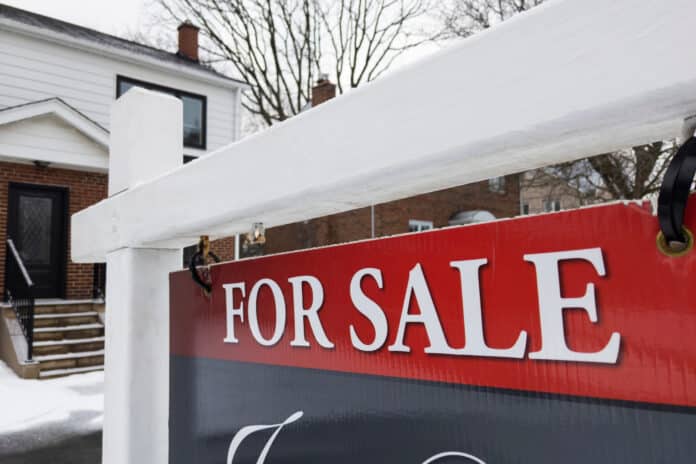U.S. citizens need to make over $100,000 a year to buy a median-priced home, with the income needed to qualify to purchase a home jumping almost 50 percent over the past four years.
“A combination of high mortgage rates, rising home prices, and low housing inventory over the last two years is pushing homeownership further out of reach for would-be homeowners, especially first-timers,” Bankrate said in an April 1 report. According to the company’s analysis, “to afford a median-priced home of $402,343, Americans need an annual income of $110,871.” This is “nearly a 50 percent increase in just the last four years.”
A six-figure annual income is now mandatory to afford a median-priced home in 22 states and the District of Columbia. Four years ago, only six states and the District of Columbia had such a high requirement.
The report blamed the affordability crisis partly on wages being unable to keep pace with rising home prices.
According to data from the Federal Reserve Bank of St. Louis, the median sales prices of new homes sold in the country jumped almost 27 percent between January 2020 and December 2023. During this period, median weekly earnings rose 20 percent, data from the U.S. Bureau of Labor Statistics (BLS) shows.
“Affordability is the biggest issue — finding a home that’s in your budget. The higher the price of a home, the harder it is to come up with the down payment or to qualify for the monthly payment,” said Bankrate housing market analyst Jeff Ostrowski. “Home values are near record highs, and if you want a house, you have little choice but to pay a high price.”
Affordability has been affected by a surge in mortgage rates as well.
“Mortgage rates jumped more than three full percentage points in the last few years. In January 2020, the average 30-year fixed rate was 3.68 percent, compared to 7.07 percent as of March 20.”
In addition to rising prices and elevated interest rates, buyers are also confronted with a third problem — a shortage of homes.
Many homeowners had purchased their properties at a time when mortgage rates were low. Since the rates are now high, selling their home would mean they have to get a new mortgage at a higher rate. This creates a “lock-in” effect where homeowners avoid listing homes for sale, thus creating a supply shortage in the market.
“Over the past few years, the supply of homes has been constrained by a number of factors, including muted homebuilding and the lock-in effect … But demand for homes has been growing, and there are more buyers than sellers,” Mr. Ostrowski said.
Region-wise, a person needs to have the highest income to afford a typical home in the West and the Northeast. In California, Hawaii, the District of Columbia, Massachusetts, and Washington, an individual should have an annual income in the range of $156,814 to $197,057.
The Midwest and South required the least income to afford a typical home. In states like Mississippi, Ohio, Arkansas, Indiana, and Kentucky, individuals need to have a yearly income between $63,043 and $65,186.
Struggling to make payments
According to a recent survey by Redfin, nearly half of American homeowners and renters “sometimes, regularly, or greatly struggle to afford their housing payments.”
The most common household spending sacrificed to afford monthly housing payments was on vacations, with more than a third of the respondents skipping vacations in the past year. People also sacrificed their meals, sold belongings, or worked extra hours.
Over one in seven individuals who faced challenges in affording housing costs delayed or skipped their medical treatments. More than one in six people dipped into their retirement savings, with a similar proportion borrowing money from family or friends.
“Housing has become so financially burdensome in America that some families can no longer afford other essentials,” said Redfin economics research lead Chen Zhao. “Homebuyers may get a reprieve in June if the Federal Reserve cuts interest rates, which would bring down the cost of getting a mortgage.”
The median downpayment for homebuyers has risen 24.1 percent from a year earlier, which is the largest annual percentage increase since April 2022, the real estate brokerage noted in a report.
“Homebuyers are doing whatever they can to pull together a large down payment in order to lower their monthly payments moving forward,” said Rachel Riva, a Redfin real estate agent in Miami.
“The smallest down payment I’ve seen recently is 25 percent. I had one client who put down 40 percent,” she said.
Over a third of the homes bought in February were made in cash amid elevated mortgage rates. While large down payments reduce the sting of high mortgage rates, all-cash purchases avoid such a burden altogether.
However, first-time homebuyers are at a disadvantage in such situations. “That’s because they don’t have equity from the sale of a previous home to bolster their down payments, and are often competing against all-cash offers, which sellers tend to favor,” Redfin noted.


















